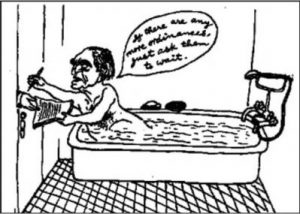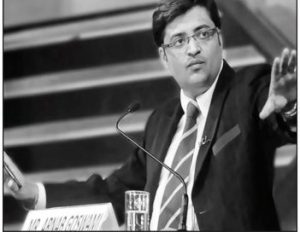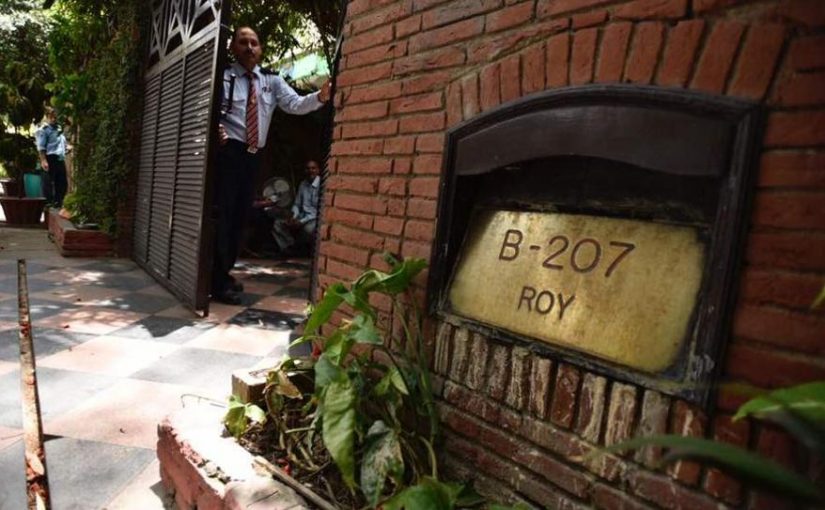INTIMIDATION: NDTV is being harassed for refusing to bow to the government. The houses of Prannoy and Radhika Roy were raided by the CBI on the charge that they had cheated a private bank
Unlike Indira Gandhi, who hit the media with the Emergency koita, the Modi government is choking the media financially, by denying advertising and carrying out raids on media houses like NDTV which are seen as hostile to the NDA government
By Rajan Narayan
IN THE wake of the CBI raids on the promoters of NDTV, Radhika Roy, who is the sister of CPM leader Brindha Karat, and Prannoy Roy, there are questions being raised on the future of the free media. Comparisons are being made between the crack down on the Indian Express during the Emergency in 1977 and the raid on NDTV. Particularly on Facebook, where most people are ignorant of history, there are lots of ill-informed comments on the threat to the media and a comparison with the Emergency declared by Indira Gandhi after the Allahabad bench of the High Court disqualified her on the charge of corrupt electoral practises.
An advantage of antiquity — I have been personal witness both to the Emergency and to the present assault on the freedom of the press — perhaps I can place events in a better perspective. The Emergency and the simultaneous muffling of the media was a sudden event. It literally happened over night. On the night of June 26, 1975 the power supply was cut off to Bhadur Shah Zafar Marg where all the newspapers in Delhi are located. The power did not come back the whole night. There was no problem with the power. The transformer was deliberately put off to prevent the newspapers from announcing that an Emergency had been declared. Indeed the proclamation of Emergency was signed by the then president, Fakhruddin Ali Ahmed, at 2 am in the morning. Leading the then famous cartoonist Abu Abraham, to show Ahmed signing the Emergency proclamation from his bath tub. By the time all of us who were then working in the media woke up on the 27th, we learnt that not only had an Emergency been declared, but that all civil liberties had been suspended — including the freedom of the press.
WITCH-HUNT BEGINS
THROUGHOUT the night of the long knifes, all the senior leaders of the opposition were arrested. This included the venerable Jaiprakash Narain who had led the movement against Indira Gandhi, George Fernandes who had called for an all India strike in the Railways, and leaders of every political party, right from right-wing leaders like Atal Bihari Vajpayee, to the extreme left leaders from the CPM. However, it was not only political leaders who were arrested. Among those taken into custody were senior journalists including VM Mulgaonkar who was editor in chief of the Indian Express and Kuldip Nayyar. It was not just editors who were arrested. Any journalist who opposed the Sanjay-Indira dictatorship was put behind bars. This included a senior assistant editor of the Times of India, Sundarrajan, who was close to me because I knew his family. The Times of India, which then, as now, sided with the party in power, abandoned his family to their fate. It was all of us journalists, who contributed from our salaries to pay his children’s fees. The worst part was that an official of the censor board that had been set up, would sit in the Indian Express office, and every word and every photograph and cartoon had to be cleared by the censor. The censors not only objected to criticism of Sanjay Gandhi’s nasbandhi and the demolition of slums, but even anything said against friends of the Gandhis’, like Amitabh Bachchan. Social activists, including women, were kept in jail with murderers and rapists.
MODI CRACKDOWN

indicators of dissent that was permitted by the censors
UNLIKE in the case of the Emergency the crack down on the press this time came immediately after Narendra Modi was sworn in as the prime minister of the country. Among the first casualties was the CNN 18 news channel which had been started by Sagarika and Rajdeep Sardesai. Rajdeep incidentally is a Goan and the son of the veteran Indian cricketer Dilip Sardesai. A large part of the finance for setting up and running the channel had come from Mukesh Ambani in the form of a loan to the promoter Rajiv Behl. After Modi was sworn in, Mukesh converted the loan into equity which made him owner of the channel. He promptly kicked out the promoter Rajiv and the founder Rajdeep Sardesai. Since then Rajdeep has been unemployed as no paper or channel has the guts to antagonize Modi and Shah by giving them a job. Worst still he is incessantly trolled by bhakts, forcing him out of Facebook.
The next casualty was Shekhar Gupta of the India Express. Modi put pressure on Vivek Goenka the owner of the Indian Express. Again overnight Vivek Goenka’s son took over as executive editor and Shekhar Gupta, the man who had built up the Express and sustained the legacy of Ramnath Goenkar, was out. After dealing with newspapers, magazines became targets of the Modi government.
Tehelka founder, Tarun Tejpal, played into the hands of his enemies when he molested one of his young employees during the Tehelka ‘Think’ fest held in Goa. Unlike other men in positions of power who get away with such crimes, or manage to retain their professional careers despite private misconduct, Tejpal’s career seems to be doomed as the case and his conduct gained unprecedented notoriety, egged on by his detractors in Delhi.
The next wicket to fall was Outlook. Soon after the magazine carried a story that went viral about RSS bhakts kidnapping young tribal girls from the North East to indoctrinate them into radical Hindutva, the editor Ramachandra was forced to quit.
DEEP POCKETS
THE dilemma of independent journalists, including the Goan Observer, which are opposed to communalism and are committed to freedom of expression, is that you cannot run print media or electronic media any longer unless you have very deep pockets. The Times of India group have always been chamchas of the party in power. But even the Times felt that Arnab Goswami was going too far in supporting the undemocratic actions of the Sangh Parivar.
However, when they sacked him, the BJP stepped in to finance the launch of his own channel ‘Republic’. Ironically the launching of Republic has made the Times of India even more fanatical. There is competition now to show who is the most patriotic.
The India Today group owned by Aroon Purie has always been pro-Sangh Parivar. The owner of the Zee Group, Subhash Chandra, is closely associated with the Vishwa Hindu Parishad, a sister organisation of the RSS. The CNN group is now owned by Reliance. The Hindustan Times has been taken over by the Birlas. All the independent senior editors have been silenced or forced to retire to digital media.
The media has been systematically targeted since the BJP came to power. Only right is right and anything written against the right is not only wrong but invites punishment.
The only voices of dissent are the online publications. Notably the Wire, edited by Siddharth Varadarajan, a former editor of the Hindu, and Scroll, which is run by the former editor of the Mumbai Mirror, Naresh Fernandes. Even in the digital media the Sangh Parivar is represented by First Post which is part of the Reliance group. But digital media does not have staying power because digital advertising is still very limited in the country.
GOAN MEDIA
THE Goan media scene is representative of what has happened in the rest of the country. The Navhind Times has always been a pro Hindu and perhaps a pro-hindutva newspaper. The Times of India is only interested in making money. The Herald will sell itself to the highest bidder. As far as the Marathi papers are concerned, the Gomantak and the Tarun Bharat are supporters of Hindutva, and Lokmat does not have the guts to take on Parrikar. Of the television channels, the most popular, Prudent, is owned by the Timblos, and Goa 365 by Shrinivas Dempo. Nobody watches HCN except those who are interested in Tiatr.
The main oxygen on which the media survives is advertising. Historically governments have withdrawn advertising to media who are perceived as hostile or not friendly. It is only the friendly chamcha papers which get all the government ads which contribute over 25 per cent of the revenue of big newspapers and 50 per cent of that of small newspapers. Similarly, Goan Observer has stopped getting Government ads since 2012 when the BJP came back to power. Similarly the BJP government has stopped ads to the Indian Express, the Hindu, and many of the main vernacular papers which protest against government policies and the attacks on the freedom of the press.
However, in addition to cutting of government ads, the latest trend of the Modi government is to also force large private advertisers to boycott media which is hostile today. On the contrary big media organisations seen to be hostile are forced to sell out to business groups which enjoy the patronage of the Modi government. An example being the sale of CNN 18 promoted by Rajdeep Sardesai to Mukesh Ambani, and Shekhar Gupta being forced out of Indian Express, as a condition for getting government ads. The Modi government does not believe in using the hammer as Indira Gandhi did. They believe in killing softly.
LIVING IN AN UNDECLARED EMERGENCY
Have you innocently shared a picture mocking the government? This April, on a complaint that a Whatsapp group shared a photo of Prime Minister Nrendra Modi which had been morphed to look “obscene and ugly”, two members of the group, one of them the admin, have been arrested, and the police are looking for another member, allegedly on the charge of sharing obscene content. The administrator is an autorickshaw driver.
June 26, 2017 will be 42 years since Emergency was imposed in 1975. And yet, there is a sense that there is an undeclared Emergency in force, with the state using both legal and illegal tools.

Unfortunately, in India the line between sedition and treason seems blurred. Treason signifies violation of allegiance to one’s state, giving aid to enemies, or levying war against one’s state Sedition is the stirring up of rebellion against the government in power. Sedition has become a tool the government can use even to discourage questioning of its actions. Hundreds of democratic activists have been arrested without reason or on false charges. Censorship is subtle but prevalent. All people’s movements and any kind of dissent is crushed. Just last week six farmers were killed in Mandsaur (MP) after the police opened fire to control crowds during a farmers’ protest.
Dr Binayak Sen, national vice-president of the People’s Union for Civil Liberties (PUCL), writer and secretary of PUCL Uttar Pradesh, Seema Azad, journalist Syed Mohammed Ahmed Kazmi, journalist K.K. Shahina, adivasi journalist Lingaram Kodopi, adivasi teacher Soni Sori, farmers’ movement leader Dr. Sunilam, Maharashtra based activists Arun Ferreira and Sudhir Dhawale, are some of the better-known victims of our modern day Emergency. The unfortunate Whatsapp administrator from Karnataka is one of the hundreds of unknown victims.
The unofficial Emergency has developed an insidious pattern. Give legitimacy to some form of censorship and then let unofficial goons act with impunity while the government stays silent or like Pontius Pilate shrugs its shoulders saying it is not responsible.
The hue and cry on cow-slaughter is one such case. By increasing restrictions on consumption of beef and sale of cattle, the government has implicitly given gau rakshaks the right to use violence against anyone even suspected of violating the law or disrespecting the ‘holy cow’.
Controlling women is another tool. The pretext of ‘protecting women is being used to prescribe how they dress and behave by people who should know better.
The BJP’s Manohar Lal Khattar blamed women for India’s rising number of rapes, saying, “If a girl is dressed decently, a boy will not look at her in the wrong way.
After two Dalit girls were gangraped and murdered in Badaun, the then Madhya Pradesh Home Minister, the BJP’s Babulal Gaur, said, “It [rape] is a social crime which depends on the man and the woman. It is sometimes right and sometimes wrong.”
Mulayam Singh Yadav, while addressing a rally said “ Rape accused should not be hanged. Boys make mistakes.” A day after Yadav’s remarks, SP State president Abu Azmi said, “ If a woman is caught ( in a rape case), then both she and the boy should be punished. In India, there is death penalty for rape, but when there’s consensual sex outside marriage, there’s no death penalty against women”.
In January 2009, after the Mangalore pub attack on women, then chief minister of Karnataka, B.S. Yeddyurappa created a stir when instead of unequivocally condemning the attack, he said that he wanted to “end the culture of boys and girls roaming around in malls holding hands”.
And those who should be speaking up for women are no better. On July 28, 2012, the Hindu Jagarane Vedike, a right-wing group, perpetuated a violent attack on a home stay in Mangalore where a birthday party was taking place. 12 boys and five girls were stripped, beaten and molested. The group’s activists claimed that the youngsters were drinking alcohol and were involved in “indecent activities”. The State Women’s Commission Chairperson Pramila Nesargi said “If you see the larger picture, those who beat up the girls were not entirely at fault. If you see a woman trying to jump into the well, you will not have time to think whether she was clad or not. This was a similar case. Won’t you beat a child if she does a mistake ? Necessity knows no law.” She also demanded that the alcohol consumption at parties be banned.
Another prominent member of a body meant to serve women, NCP leader and Maharashtra Women’s Commission member Asha Mirge said Nirbhaya was responsible for her rape as she was out with a friend late at night and went on to warn women to remain careful lest they invite such incidents.
Given this atmosphere, it came as no surprise that Yogi Adityanath’s ‘romeo’ squads terrorise couples instead of protecting women.
And the less said about state-sponsored trolls on social media the better!
